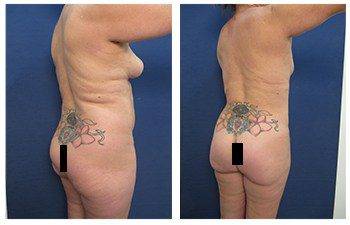
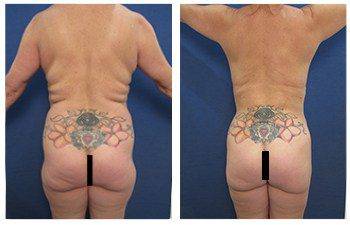
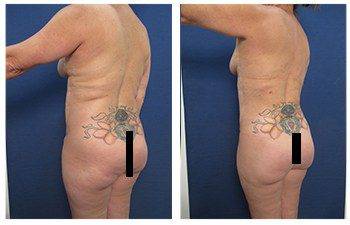

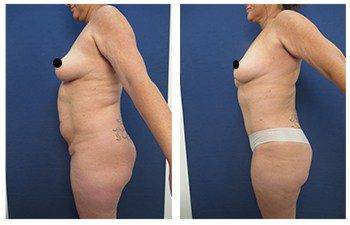
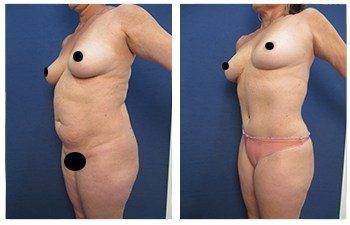

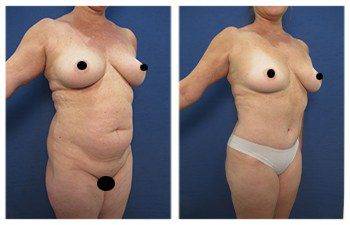
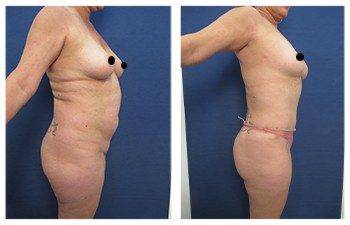
Introduction: VASER Liposuction of Thighs
VASER liposuction of thighs requires consideration of several factors including the degree of excess fat, amount of skin redundancy, and whether fat grafting is required to achieve optimal contour lines.
Excess fat in each thigh must be evaluated independently as most individuals present with variable-sized and shaped thighs. Furthermore, the degree of fat excess in the medial versus the lateral thighs varies significantly. The medial thighs tend to possess fat in the superficial layer whereas the lateral thighs carry their fat in the deep layer. As such, VASER liposuction in the thighs requires the administration of ultrasound in two separate layers.
Following the administration of ultrasound, liposuction should be performed only in the superficial plane whereas liposuction should be performed only in the deep plane. This differentiation in fat layer removal is also critical when you consider anatomic differences and contour goals.
For example, the superficial fat layer of the lateral thighs should be maintained where any superficial irregularities would be apparent. In contrast, the medial thighs especially the posterior thighs are prone to sagging if the deeper retaining ligaments are disrupted.
Amount of redundant skin in the thighs VASER liposuction in the medial thighs is guided towards the superficial layer. This is because the skin of the medial thighs is the thinnest and most redundant of the body.
Tightening of the medial skin can be accomplished best with Renuvion subdermal coagulation which utilizes combined technology of Helium activated plasma and radiofrequency energies that will thermally contract the collagen molecules of the skin and fibroseptal network most dense in the superficial layer of the skin.
Coined subdermal coagulation, this technology is able to direct this energy in the superficial plane of the skin to provide the most efficacious medial thigh tightening. In contrast, the lateral thighs are not amenable to having Renuvion subdermal coagulation treatment since the superficial fat layer is maintained to avoid Fat transfer to optimize contour lines Fat transfer to the upper lateral thighs is a routine requirement as the lateral thighs are intimately associated with the lateral buttock region. When optimizing the buttock contour, patients utilize the Buttock Assessment Tool to choose the ideal buttock size and shape. Of the shape permutations demonstrated, clients most favor maximizing the mid-lower buttock volume.
Finally, when attempting to maximize the mid-lower buttock region, it becomes critical to not only VASER liposuction the lower-mid lateral thighs but to simultaneously fat graft the mid-upper lateral thighs. This is because ideal feminine contour lines require smooth transitions between the lower back and buttocks as well as the buttock and lateral thighs.
Thigh VASER Liposuction Before & Aftern
Vaser liposuction is a minimally invasive procedure that targets fat cells in the thighs, resulting in a slimmer, more contoured appearance. Before the procedure, patients may experience excess fat in the upper inner, outer, front, and back thighs, leading to a lack of definition and an undesirable shape. After Vaser liposuction, the reduction of fat cells in these areas can lead to a more toned and sculpted look, with improved proportions and symmetry.
It’s important to note that results may vary for each individual patient, as factors such as skin elasticity and overall health can impact the outcome. Suitable candidates for Vaser liposuction may also consider other body contouring options, such as skin tightening treatments or thigh lift surgery, to achieve their desired aesthetic goals.
Potential risks and side effects of Vaser liposuction on the thighs may include temporary bruising, swelling, and discomfort. In rare cases, uneven contours, fluid accumulation, or changes in sensation may occur. It’s essential for patients to discuss the potential risks and complications with a qualified plastic surgeon before undergoing the procedure. Overall, Vaser liposuction can be an effective option for reducing fat in the thighs and improving body proportions.
What is Vaser Thigh Liposuction
Vaser Thigh Liposuction: Vaser Thigh Liposuction is a minimally invasive surgical procedure that utilizes ultrasound technology to break down and remove stubborn fat deposits from the thighs. This innovative technique targets specific areas of the thighs, resulting in smoother, more contoured legs with minimal scarring and downtime. Vaser Thigh Liposuction is ideal for individuals who struggle with localized fat deposits in the thigh area, despite maintaining a healthy diet and regular exercise. This procedure offers a safe and effective solution for achieving sculpted and toned thighs, enhancing overall body proportions, and boosting confidence. With its precise and gentle approach, Vaser Thigh Liposuction has become a popular choice for individuals looking to improve the appearance of their thighs and achieve their desired aesthetic goals.
Understanding Vaser Thigh Liposuction
VASER liposuction of the thighs requires careful consideration of several key factors to achieve optimal results. The degree of excess fat in the thighs must be evaluated, as this will determine the amount of fat that needs to be removed. Additionally, the amount of redundant skin should be assessed to determine if additional skin tightening procedures may be needed. In some cases, fat transfer may be necessary to optimize contour lines and achieve a more aesthetically pleasing result.
It is essential to evaluate each thigh independently, considering the differences between the medial and lateral thighs. This allows for a more customized approach to addressing the specific needs of each area, ensuring a symmetrical and balanced outcome.
Administering ultrasound in two separate layers is a critical step in VASER liposuction of the thighs. This allows for the effective removal of fat while minimizing trauma to the surrounding tissues. The ultrasound energy emulsifies the fat, making it easier to extract, and also stimulates collagen production for skin tightening.
In conclusion, VASER liposuction of the thighs requires a thorough assessment of excess fat, skin redundancy, and the potential need for fat transfer. Additionally, careful evaluation of each thigh independently and precise administration of ultrasound in two separate layers is crucial for achieving optimal results.
Preparing for a Thigh VASER Liposuction procedure
Before undergoing a Thigh VASER Liposuction procedure, it is important to prepare properly. This includes informing your doctor of any medications you are currently taking, as certain medications may need to be adjusted or temporarily stopped prior to the procedure. Additionally, it is crucial to avoid blood-thinning medications, such as aspirin, ibuprofen, and certain herbal supplements, as these can increase the risk of bleeding during the procedure.
It is also recommended to refrain from consuming alcohol for a certain period of time before the surgery, as alcohol can affect the body’s ability to heal and may contribute to bleeding issues. Your doctor will provide specific instructions on how to prepare for the procedure, including any dietary restrictions or additional steps to take in the days leading up to the surgery.
By following these guidelines and any additional instructions provided by your doctor, you can ensure that you are properly prepared for your Thigh VASER Liposuction procedure and minimize any potential risks or complications.
Recovering from Thigh VASER Liposuction
Recovering from thigh VASER liposuction is a crucial part of the overall process. After undergoing the procedure, it is essential to take the necessary steps to ensure a smooth and successful recovery. This includes following post-operative care instructions, managing any discomfort or swelling, and gradually reintroducing physical activity. Understanding the recovery process and being prepared for what to expect can help patients achieve the best possible results and minimize the risk of complications. In this article, we will explore the key aspects of recovering from thigh VASER liposuction and provide helpful tips for a safe and effective recovery journey.
Price for a Thigh Liposuction procedure
The cost of Thigh Liposuction procedures can vary based on several factors. Body shape and size play a significant role, as larger or more complex areas may require more time and effort to achieve the desired results. Anticipated surgery time, type of anesthetic, and surgical complexity also contribute to the overall cost.
At Cosmos Aesthetics and the ABS Institute, a personalized approach to pricing is emphasized. Each patient’s unique anatomy and specific aesthetic goals are carefully considered when determining the cost of the procedure. This individualized approach ensures that patients receive a tailored treatment plan and accurate pricing based on their specific needs.
By taking into account the various pricing factors and personalizing the approach, Cosmos Aesthetics, and the ABS Institute strive to provide transparent and fair pricing for Thigh Liposuction procedures, ensuring that patients receive high-quality care that is tailored to their individual requirements.
Understanding Female Thighs
The female thighs are a prominent feature of the human body and they play an important role in both appearance and functionality. Understanding the anatomy, composition, and potential areas of concern for female thighs is key to appreciating their diversity and unique characteristics. From cellulite and fat distribution to muscle strength and flexibility, the female thighs are a complex and fascinating part of the body. In this article, we will delve into the various aspects of understanding female thighs, including their physical attributes, common issues, and the importance of embracing body positivity and confidence. Whether for health and fitness or simply for appreciation of the female form, gaining a deeper understanding of female thighs can lead to a more holistic and empowered approach to women’s bodies.
What are the components of Female Thighs?
The components of female thighs include the inner thigh, outer thigh, and knee. The inner thigh consists of the adductor muscles, which are responsible for bringing the legs together. The outer thigh, also known as the saddlebags, is located on the lateral side of the thigh and consists of muscles and subcutaneous fat. The knee includes the patella (kneecap), ligaments, tendons, and surrounding soft tissue.
VASER liposuction is a minimally invasive procedure that can be used to shape and contour the thighs. This procedure targets excess fat in the inner and outer thighs, reducing chafing and rubbing often experienced in this area. By selectively removing fat, VASER liposuction can create smoother, more defined contours in the thighs. Treating both the inner thigh and inner knee can also improve symmetry and achieve optimal results. This procedure offers the benefit of reducing excess fat in these areas, resulting in a more proportionate and aesthetically pleasing appearance.
In conclusion, understanding the components of female thighs and the benefits of VASER liposuction for shaping and contouring can help individuals achieve their desired aesthetic goals for their thighs and knees.
What are the surgical options for Thigh Reduction?
Surgical options for thigh reduction include traditional liposuction, thigh lift surgery, and Vaser liposuction. Vaser liposuction is a minimally invasive and effective option for reducing inner thigh fat. It uses ultrasound technology to break up and liquefy the fat before it is gently suctioned out, allowing for more precise and targeted fat removal compared to traditional liposuction.
Vaser liposuction is a safe and gentle treatment option, with a shorter recovery time compared to traditional liposuction. This is because it causes less trauma to the surrounding tissues and blood vessels, resulting in less pain, bruising, and swelling, and a quicker return to normal activities.
The benefits and potential results of Vaser liposuction for inner thigh fat reduction include improved contour and definition in the thighs, smoother skin, and minimal scarring. The procedure can also help address asymmetry and irregularities in the thighs, leading to a more proportionate and balanced appearance. Overall, Vaser liposuction offers a less invasive and more precise option for those seeking to reduce inner thigh fat and achieve a more sculpted and toned thigh area.
Traditional Liposuction Vs. VASER Hi Def Lipo for Legs
When it comes to body contouring and fat reduction for the legs, there are different options available, each with its own set of benefits and considerations. Traditional liposuction has been a common method used to remove excess fat from the legs, but VASER Hi Def Lipo is a newer and more advanced technique that offers a higher level of precision and results. In this overview, we will compare and contrast these two methods to help you better understand the differences, advantages, and potential outcomes of Traditional Liposuction Vs. VASER Hi Def Lipo for Legs.
Thigh VASER Liposuction
Thigh VASER liposuction is a specialized procedure that involves evaluating the excess fat in the thighs and addressing redundant skin to optimize contour lines with fat transfer. The process begins with a thorough assessment of the patient’s individual anatomy and desired results.
During the procedure, the use of ultrasound administration in two separate layers is crucial to effectively target and emulsify the excess fat, while maintaining the superficial fat layer in certain areas to ensure a smooth and natural appearance post-surgery.
Additionally, fat transfer to the upper lateral thighs is routinely required to enhance the overall shape and symmetry of the thighs. The Buttock Assessment Tool is utilized to choose the ideal buttock size and shape, ensuring that the proportions are harmonious with the newly contoured thighs.
Overall, VASER liposuction of the thighs involves a comprehensive approach that addresses excess fat, redundant skin, and optimal contour lines with the use of ultrasound administration and fat transfer, ultimately leading to improved aesthetic outcomes.
Thigh Renuvion skin tightening
Thigh Renuvion is a cutting-edge skin tightening procedure that complements inner thigh liposuction by enhancing the results and improving skin elasticity. This procedure utilizes radiofrequency-assisted lipolysis (RFAL) technology to deliver controlled thermal energy to the targeted area, stimulating collagen production and tightening the skin.
By combining Thigh Renuvion with inner thigh liposuction, patients can achieve more comprehensive and satisfying results. The skin tightening benefits of Thigh Renuvion will prevent loose or sagging skin often associated with liposuction, resulting in a smoother and more toned appearance. This innovative procedure is especially beneficial for individuals looking to refine and contour their inner thighs while also improving the overall quality of their skin.
The Thigh Renuvion process involves the insertion of a slender wand under the skin, where radiofrequency energy is directed to the specific treatment area. This results in immediate tissue contraction and continued improvement in skin elasticity over the following months. The outcome is firmer, more youthful-looking skin that complements the slimmer contours achieved through liposuction. Thigh Renuvion offers patients the opportunity to achieve their desired aesthetic goals with enhanced confidence and satisfaction.
Thigh Fat grafting
Thigh fat grafting is a cosmetic procedure that involves removing excess fat from one area of the body, such as the abdomen or thighs, and injecting it into the thighs to enhance their shape and tightness. This technique is commonly used to improve the contour of the thigh muscles, creating a more toned and sculpted appearance. In addition to muscle enhancement, thigh fat grafting is also applicable in gluteal and breast enhancements, where the transferred fat can be used to add volume and improve the overall shape of these areas.
It’s important to note the difference between inner thigh fat removal and a thigh lift. Inner thigh fat removal targets only the fat in the inner thigh area, while a thigh lift addresses the excess skin and overall shape of the thigh. While both procedures can improve the appearance of the thighs, they target different aspects of the thigh’s aesthetics.
In conclusion, thigh fat grafting is a versatile technique that can be used to enhance the shape and tightness of the thigh muscles, as well as to improve the appearance of the gluteal and breast areas through fat transfer. Understanding the differences between inner thigh fat removal and a thigh lift is essential in determining the most suitable procedure for individual aesthetic goals.
Conclusion: Thigh VASER Liposuction
Thigh VASER Liposuction is a minimally invasive procedure that effectively removes excess fat from the thighs and knees, resulting in a smoother and more contoured lower body. The benefits of this procedure include precise fat removal, minimal scarring, and quicker recovery compared to traditional liposuction. The potential risks of Thigh VASER Liposuction include bruising, swelling, and potential irregularities in the skin.
The procedure involves injecting tumescent fluid into the treatment area, followed by the insertion of a VASER probe to break down and emulsify the fat cells. The liquefied fat is then gently suctioned out, resulting in improved body contour. The healing period typically involves wearing compression garments and limiting physical activity for a few weeks.
It’s crucial for individuals considering Thigh VASER Liposuction to have realistic expectations about the potential results and understand the seriousness of the decision to undergo this body contouring procedure. Thigh VASER Liposuction can effectively target areas of the thighs and knees, resulting in a slimmer and more proportioned lower body. However, it’s important to consult with a qualified surgeon to determine if this procedure is the right option for specific body goals.
VASER liposuction in general demands high definition high-definition liposuction standards in contouring and outcomes. This same standard holds not only for the entire body but also for the thighs. Finally, when we evaluate the thighs we must not only evaluate each leg independently but also consider the medial versus lateral thigh requirements as well.
In summary, VASER liposuction of thighs summary VASER liposuction of thighs requires acknowledgment of excess fat, skin redundancy, and simultaneous fat grafting to ensure optimum contour lines. Effective VASER liposuction of thighs needs consideration of each thigh as well as differential treatment of the medial thighs versus lateral thighs. Attention to detail is critical to achieving high-definition body contouring results.

